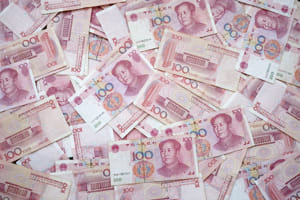There are numerous articles mentioning that Saudi Arabia may use the Yuan, China’s domestic currency, for its oil exports.

How much does Saudi Arabia export to China? According to the OEC, the kingdom’s main exports are to China ($45.8B), India ($25.1B), Japan ($24.5B), South Korea ($19.5B), and the United States ($12.2B). Exports of crude oil reached $145 billion in total.
Saudi Arabia is the world’s largest oil exporter at $145 billion, and China the largest buyer at $204 billion, with 2019 figures.
Saudi Arabia’s public accounts are exemplary. From a 4.8% deficit, the kingdom expects a surplus in 2022 and its public debt to GDP is 30.8%, one of the lowest in the world.
Does Saudi Arabia need to use the yuan at all? No. Its foreign currency reserves including gold stood at $472.8 billion in 2020 despite the pandemic-led slump in exports and oil demand. Is it in any pressure to change currency? Even less so. Its reserves comfortably cover its external debt, giving an enviable level of stability compared to other OPEC nations that have large trade and fiscal deficits.
What would Saudi Arabia gain from using the Yuan? Not higher exports to China. The Asia giant needs its oil imports more than Saudi Arabia needs its domestic currency. There is no real evidence that exports to China would fall if Saudi Arabia continued to use the US dollar.
The yuan utilization in global transactions is very limited. According to Bloomberg, “activity in the renminbi, as the currency is also called, rose to its second-highest level ever in 2021” using figures compiled by the Society for Worldwide Interbank Financial Telecommunications. However, that means a stubbornly modest 2.7% of the market versus the dollar at 41%, which has held the top slot for decades. The euro is used in 36.6%, the GBP in 5.9% -more than double the use of the Yuan despite being a much smaller economy-, and the Japanese yen is used as much as the yuan at 2.6%.
More importantly, despite the large increase in importance of the Chinese economy in the global landscape, its importance as a currency has barely improved from its 2015 high, when it reached the fourth spot.
Why is the yuan only used in 2.7% of global transaction despite being 14% of the world’s GDP and what happened in 2015?
The yuan is the only currency from a global economic leader that has capital controls and a fixed pricing set by the PBOC. As such, any holder of the Chinese currency finds a constant threat from an abrupt devaluation and the inability to use the currency freely in payments.
And that is exactly what happened in 2015. The Chinese central bank announced an aggressive devaluation.
The yuan is not an alternative to the US dollar because of capital controls, fixed pricing and, even worse, because monetary policy is even more aggressive than that of the Federal Reserve. The expansion of money supply in China has been multiple times over that of the United States for two decades with significantly lower global demand.
It is also worth noting that even the large Chinese oil companies favour the US dollar for international transactions. Looking at the open interest in the Shanghai Commodity Index, the so-called petroyuan index, we can see that there is an extremely limited use of the yuan in global oil transactions.
China’s apparently large gold reserves stand at less than 0.3% of its money supply (M2) and its undoubtedly large US dollar reserves, $3.35 trillion, barely cover its foreign exchange liabilities.
If oil and commodity producers in other countries, particularly Latin America, have accepted China’s currency in the past it has been due to the large debt commitments they acquired with the Asian giant, not for practical reserve currency use reasons.
Any commodity producer that accepts the yuan instead of the US dollar must know that capital controls and price fixing are very important threats, and there is no real indication that the PBOC is going to change any of those.
The reality is that the yuan has all the negative elements of all fiat currencies, massive printing, lack of real support, incentive of the central bank to erode its purchasing power, and none of the benefits of the dollar, euro or pound, the free float pricing, legal and investor security, and a widespread open financial system.
Saudi Arabia might use some yuan in its oil exports, but the reality is that no fiat currency with capital controls is a real alternative to other fiat currencies, and that the advent of central bank digital currencies makes this problem larger. Central bank digital currencies are surveillance disguised as money and the risks of massive printing, erosion of purchasing power and control of transactions is much larger than in traditional currencies.
Saudi Arabia could prefer gold or cryptocurrencies to escape the money printing machine, but hardly replace a heavily-printed but open and secure fiat currency, the US dollar, with a closed and less secure one.